|
||||||||||||||||||||||
![Home - Air Power Australia Website [Click for more ...]](APA/APA-Title-Main.png) |
||||||||||||||||||||||
![Sukhoi PAK-FA and Flanker Index Page [Click for more ...]](APA/flanker.png) |
![F-35 Joint Strike Fighter Index Page [Click for more ...]](APA/jsf.png) |
![Weapons Technology Index Page [Click for more ...]](APA/weps.png) |
![News and Media Related Material Index Page [Click for more ...]](APA/media.png) |
|||||||||||||||||||
![Surface to Air Missile Systems / Integrated Air Defence Systems Index Page [Click for more ...]](APA/sams-iads.png) |
![Ballistic Missiles and Missile Defence Page [Click for more ...]](APA/msls-bmd.png) |
![Air Power and National Military Strategy Index Page [Click for more ...]](APA/strategy.png) |
![Military Aviation Historical Topics Index Page [Click for more ...]](APA/history.png)
|
![Intelligence, Surveillance and Reconnaissance and Network Centric Warfare Index Page [Click for more ...]](APA/isr-ncw.png) |
![Information Warfare / Operations and Electronic Warfare Index Page [Click for more ...]](APA/iw.png) |
![Systems and Basic Technology Index Page [Click for more ...]](APA/technology.png) |
![Related Links Index Page [Click for more ...]](APA/links.png) |
|||||||||||||||
![Homepage of Australia's First Online Journal Covering Air Power Issues (ISSN 1832-2433) [Click for more ...]](APA/apa-analyses.png) |
||||||||||||||||||||||
| Last Updated: Mon Jan 27 11:18:09 UTC 2014 | ||||||||||||||||||||||
|
||||||||||||||||||||||
|
S-200VE Vega / SA-5
Gammon Missile Site Design
Technical Report APA-TR-2009-0603-A |
|
| by
Dr Carlo Kopp, AFAIAA, SMIEEE, PEng July 2009 Updated April, 2012 Text, Line Art © 2009 - 2012 Carlo Kopp |
|
 The 5V21/5V28 SA-5A/B/C Gammon missile is deployed on the semimobile 5P72 series launcher. The weapon is typically deployed at static semi-hardened SAM sites (via Vestnik PVO). |
|
IntroductionThe 160 nautical mile range
class Almaz S-200 / SA-5 Gammon missile system was the largest and
longest ranging
Surface to Air Missile (SAM) developed and operationally deployed by
the
Warsaw Pact nations during the Cold War, and it remains the longest
ranging
SAM currently in operational use. The weapon remains deployed by a
number of nations, including Iran and the DPRK.
The ongoing operational use of the S-200 / SA-5 Gammon makes it a worthwhile subject for study, especially given the availability of technology insertion upgrades for the system, and its exceptional range performance, subject to variant between 250 km and 300 km (135 NMI to 160 NMI). The collapse of the Warsaw Pact and subsequently, the Soviet Union, has provided unprecedented access to technical material detailing this weapon system, but also access to former operational S-200 / SA-5 SAM sites. As these sites have typically been constructed to a Soviet supplied design, they will provide a good example of the detail design and construction of sites used by current operators, including Iran and the DPRK. Numerous S-200 / SA-5 SAM sites were constructed during the 1980s in a chain extending from East Germany, through the former Czechoslovakia, with the southern end of the SAM belt sited in Hungary. The intent behind this SAM belt was to deny NATO the use of its standoff ISR assets, specifically the E-3 AWACS, E-8 JSTARS, RC-135V/W Rivet Joint, TR-1/U-2, and its potent fleet of EF-111A Raven tactical jammers. In contemporary terms, the purpose of these installations would be described as producing an “ISR lockout”. The Soviets provisioned to deploy nuclear armed 5V28 rounds, equipped with 25 kilotonne fission warheads, from these sites. The planned and constructed SAM belt sites, north to south, were:
Claims that Romania also operated
the S-200VE / SA-5B remain difficult to support with evidence.
These sites were mostly
decommissioned
through the 1990s as most of the newly independent nations
progressively
severed connections with the Russians, and progressed to NATO
membership.
|
|
S-200 Battery Deployment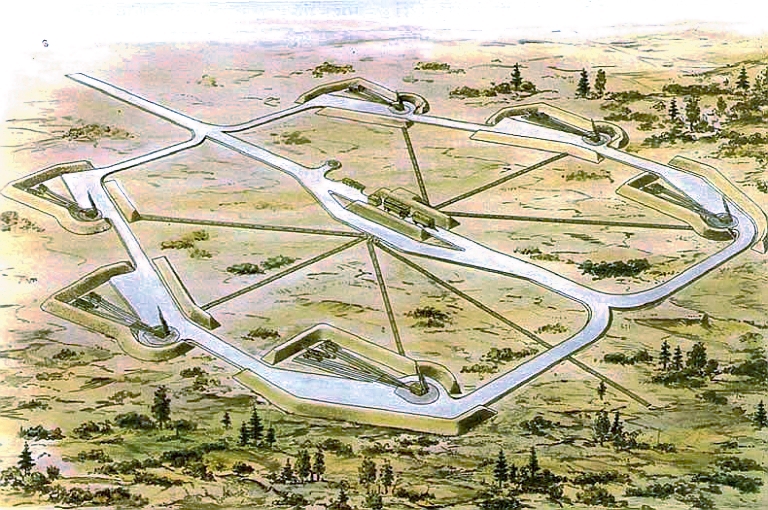 Early configuration S-200 battery
deployment
illustration from Soviet technical manual. Note each launcher has a
pair of 5Yu24 rail transloaders with ready 5V28 rounds (Almaz).
A typical early model S-200
battery comprised a single 5N62 Square Pair engagement radar, and six
5P72
launchers, each supported by a pair of 5Yu24 rail transloaders. This
provided for six ready rounds on launch rails, and up to twelve reloads
on
rail transloaders being fuelled and prepared. Initially, revetted
installations with earth berms were used, but the vulnerability of such
revetted sites used with the S-75 / SA-2 observed in Vietnam and the
Middle East led to more aggressive measures, with the transloaders
located in bunkers, shelters or tunnels, and revetments clad with
concrete.
The Warsaw Pact S-200VE / SA-5B SAM belt sites were mostly constructed in the latter fashion, using design plans provided by the Soviets. The sites employed hardened shelters for all of the radar vans and support equipment. Hardened shelters were also provided to protect the missile launch control centre vans and missile magazines. The late model S-200VE / SA-5B included the towed 5Yu24M/5T83 transloader/transporter semi-trailer which could directly load the missile launchers, although most of the sites still retained the legacy 5Yu24 rail transloaders for ready rounds. |
|
|
|
 Dobříš Site VÚ 5180, 17., 18., 19. PRO, 71 PLRB (Praha), CSLAThe Dobříš S-200VE / SA-5B site
was constructed in secrecy between 1981 and 1985, by a workforce of
1,500 personnel. The site hosted three 5N62V Square Pair engagement
radars, and three missile launch sites each with six launchers and one
K-3 launch control centre van. A single P-14/5N84E Tall King C
acquisition radar was
employed, supported by a PRV-17 Odd Pair heightfinding radar. The
Square Pair radars were deployed on large elevated concrete platforms.
The K-2 operator van for the 5N62V/K-1V radar head was sited inside a
hardened shelter at the base of elevated platform.
The area of the Dobříš site was divided into three sections:
The site was hardened not only
against air attack, but also against special forces raids on the
ground. The site perimeter was protected by a 10 ft high reinforced
concrete wall. Entry gates were protected by concrete pillboxes
intended for light machine guns crews.
The site was operated by a complement of 160 officers and NCOs, and 360 enlisted personnel.  Dobříš
S-200VE / SA-5B site (http://www.fortifikace.net/pov_pvos_skupina_vega.html).
|
|
Radar and C3I InstallationsThe Dobříš site was equipped
with the standard complement of radar equipment for an S-200VE battery.
Acquisition was performed by a single long range P-14/5N84AE Oborona /
Tall King C VHF-Band radar, supported by a PRV-17 Odd Pair heightfinder
and a 1L22 Parol Secondary Surveillance Radar (Soviet IFF).
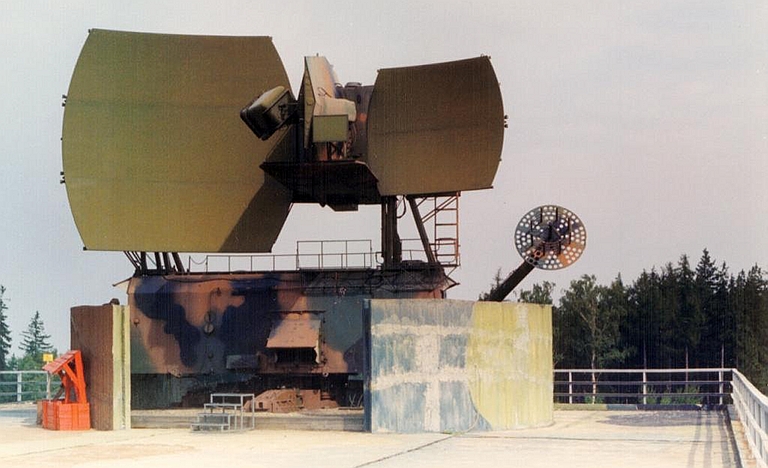 5N62V Square Pair B K-1V radar head van
located behind a protective screen on an elevated platform (image Matej
Kopecky).
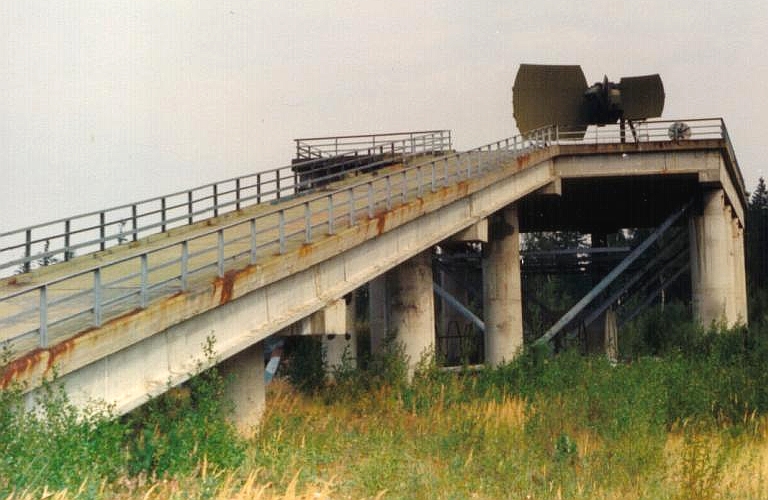 5N62V
Square Pair B K-1V radar head van on an elevated platform (image Matej
Kopecky).
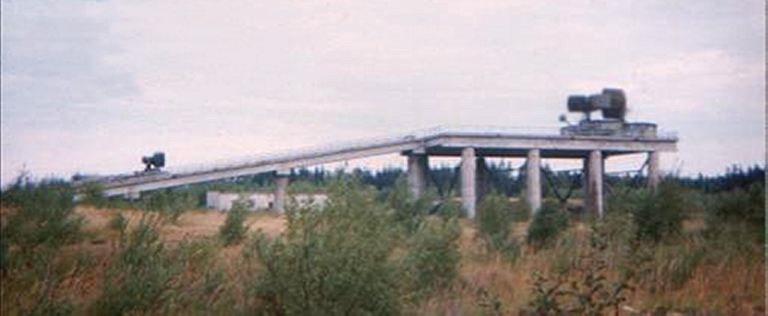 View
of two of the three elevated
platforms for the 5N62V Square Pair radars (image Pavel Kisling).
 The K-2 radar control van and K-22
converter van are sited in a hardened shelter at the base of the
platform. The cable runs to the K-1V van are routed through the hollow
support columns.
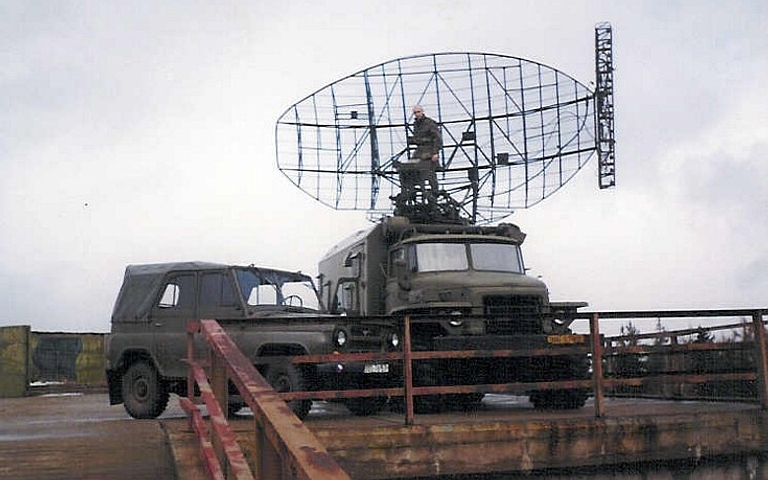 1L22
Parol IFF interrogator on one of the platforms.
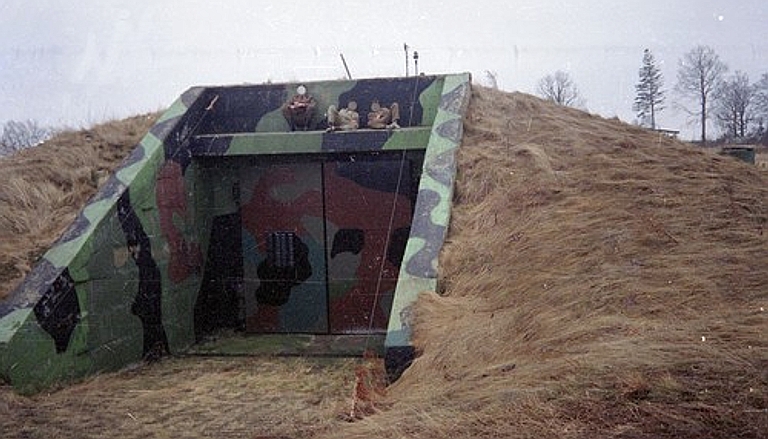 The K-3 launch control centre van
is used
to control the 5P72 launchers. Each K-3 and its supporting generator
are located in hardened shelters.
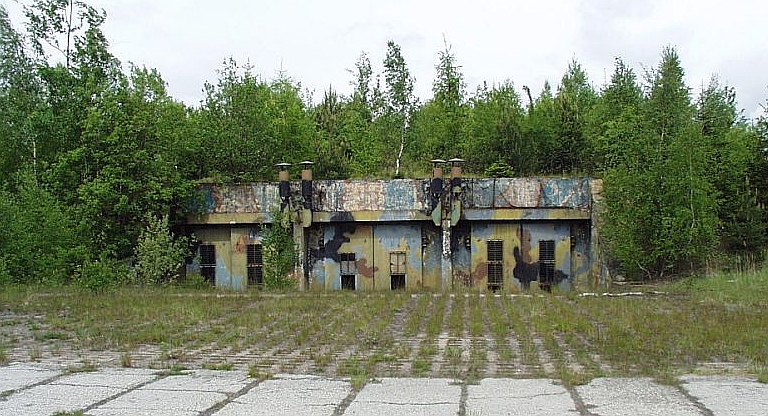 Hardened Command Post for the site.  PRV-17 Odd Pair heightfinder. 5V28VE Missile Assembly and DeploymentTo sustain a viable rate of
fire the Dobříš site employed a defacto assembly line for preparing
stored missile rounds for use. Missile kits would be removed from the
magazine, assembled in a hangar, and then transferred to a checkout
hangar where the missile avionics and systems would be tested. The
missiles were then fuelled and transfered to transloaders, or to
launchers for use.
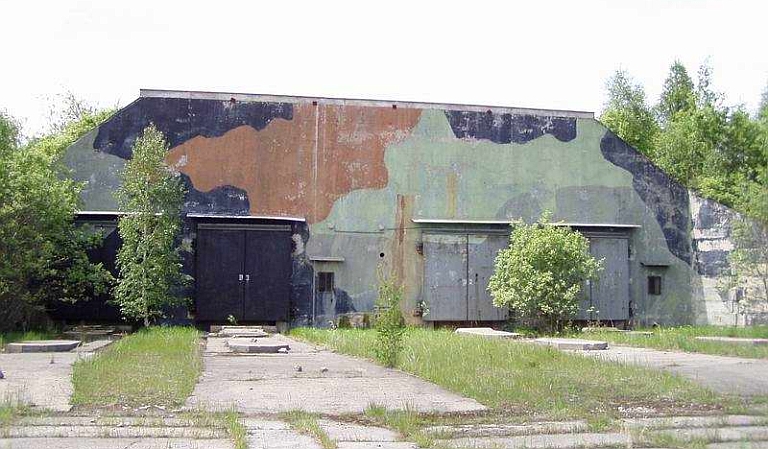 Building 21, the hardened missile
magazine, above and below. Missile kits were held in storage here. The
design is clearly capable of withstanding dumb bomb attacks but is not
sufficiently hardened to withstand the BLU-109/B or BLU-116/B.
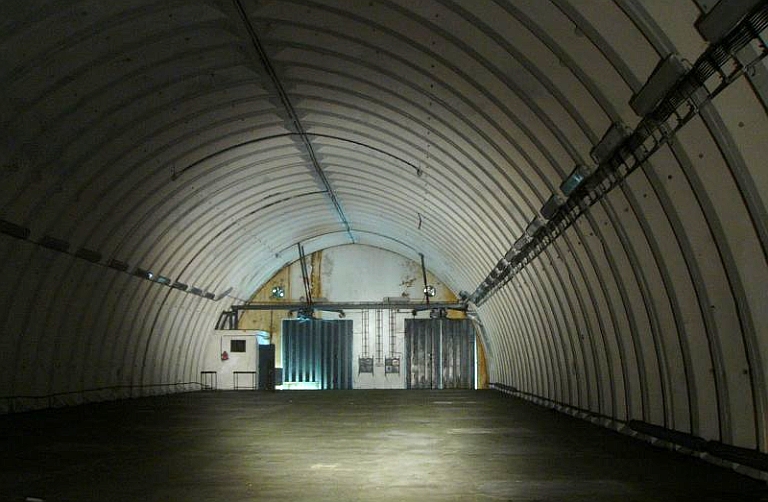  Missile assembly hangar, above and below. An overhead gantry crane is used to move the missiles to the transloader/transporter semi-trailers.  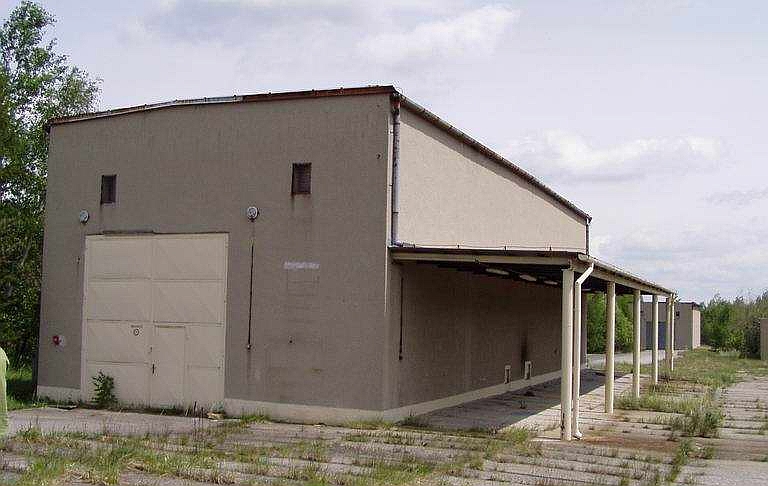 Buildings 22, 23, and 24 form the drive
through missile checkout hangar, where assembled 5V28VE rounds would be
hooked up to a KIPS 5K43E diagnostic station, comprising an AM-43 test
system on a URAL-375A chassis. Assembled and tested missiles could be
returned to storage, or fuelled for use.
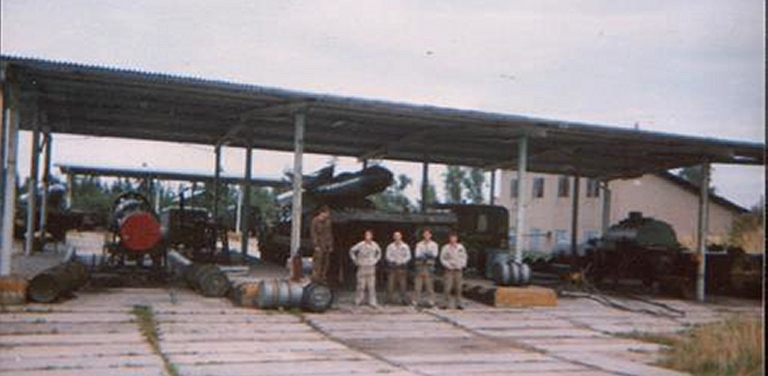 Missile fuelling and defuelling shelter.
Up to two rounds could be refuelled concurrently with the two component
AK-27I/TG-02 hypergolic fuel. A single ZAK-21 3,000 litre tanker was
used. The toxic, carcinogenic, corrosive and inflammable
propellants required special handling and decontamination
equipment. Fuelling and defuelling a missile reduced its shelf life
from 20 years to 5 years. The missiles are carried on a 5T82M1E/5Yu24M
transporter/transloader (images Pavel Kisling).
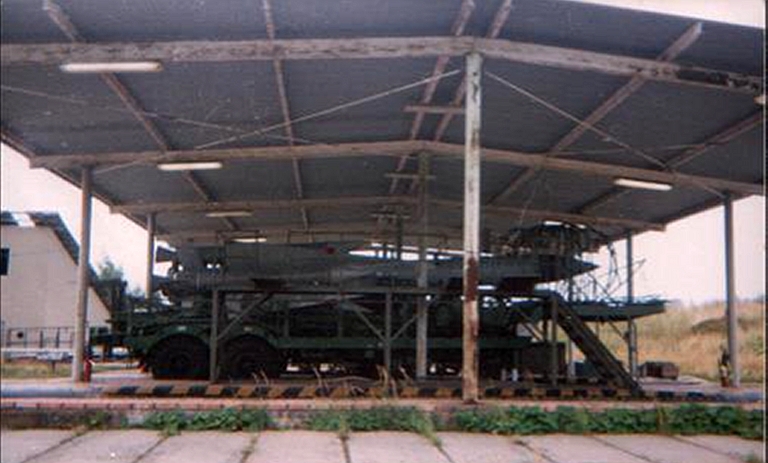  5Yu24M
transporter/transloader (image Pavel
Kisling).
 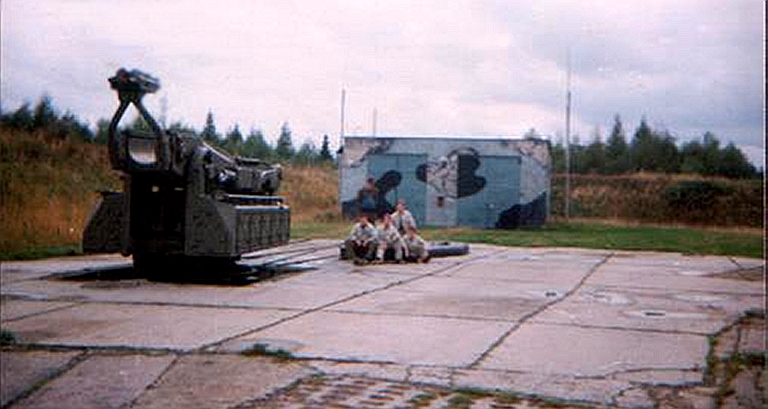 5P72VE launcher (image Pavel Kisling).
 5V28VE Vega / SA-5B Gammon being
transfered from the 5Yu24 to the 5P72VE launcher (image Matej Kopecky).
 5V28VE
Vega / SA-5B Gammon fully elevated on the 5P72 launcher (image Matej Kopecky).
APA highly recommends the Czech language site detailing the Dobříš installation: http://www.fortifikace.net/pov_pvos_skupina_vega.html |
|
Rapotice Site VÚ 7300, 9., 10. PRO, 76 PLRB (Brno), CSLAThe Rapotice S-200VE / SA-5B
site was like its sibling constructed in secrecy between 1981
and 1985. The site hosted two
5N62V Square Pair engagement radars, and two missile launch sites,
each with six launchers and one K-3 control van. A single P-14/5N84E
Tall King C acquisition radar was employed, supported by a PRV-17 Odd
Pair heightfinding radar. The site largely follows the detail design of
the Dobříš site with similar or identical buildings and shelters.
 |
|
| APA highly recommends
the
Czech language site detailing the Rapotice installation: http://www.fortifikace.net/pov_pvos_skupina_vega_rapotice.html |
|
References/Sources
|
|
|
Technical
Report APA-TR-2009-0603-A
|
|
|
|||||||||||||
![Sukhoi PAK-FA and Flanker Index Page [Click for more ...]](APA/flanker.png) |
![F-35 Joint Strike Fighter Index Page [Click for more ...]](APA/jsf.png) |
![Weapons Technology Index Page [Click for more ...]](APA/weps.png) |
![News and Media Related Material Index Page [Click for more ...]](APA/media.png) |
||||||||||
![Surface to Air Missile Systems / Integrated Air Defence Systems Index Page [Click for more ...]](APA/sams-iads.png) |
![Ballistic Missiles and Missile Defence Page [Click for more ...]](APA/msls-bmd.png) |
![Air Power and National Military Strategy Index Page [Click for more ...]](APA/strategy.png) |
![Military Aviation Historical Topics Index Page [Click for more ...]](APA/history.png)
|
![Information Warfare / Operations and Electronic Warfare Index Page [Click for more ...]](APA/iw.png) |
![Systems and Basic Technology Index Page [Click for more ...]](APA/technology.png) |
![Related Links Index Page [Click for more ...]](APA/links.png) |
|||||||
![Homepage of Australia's First Online Journal Covering Air Power Issues (ISSN 1832-2433) [Click for more ...]](APA/apa-analyses.png) |
|||||||||||||
| Artwork, graphic design, layout and text © 2004 - 2014 Carlo Kopp; Text © 2004 - 2014 Peter Goon; All rights reserved. Recommended browsers. Contact webmaster. Site navigation hints. Current hot topics. | |||||||||||||
|
Site Update
Status:
$Revision: 1.753 $
Site History: Notices
and
Updates / NLA Pandora Archive
|
|||||||||||||
|
|
Tweet | Follow @APA_Updates | |||||||||||
|
|
|||||||||||||
|
|
|||||||||||||
![F-111 Aardvark Index Page [Click for more ...]](APA/f-111.png)
![F/A-18 Hornet and Super Hornet Index Page [Click for more ...]](APA/fa-18a.png)
![Aerial Refuelling and Airlift Capabilities Index Page [Click for more ...]](APA/aar-lift.png)
![Directed Energy Weapons and Electromagnetic Bombs Index Page [Click for more ...]](APA/dew.png)
![Notices and Updates Index Page [Click for more ...]](APA/notices-128.png)
![APA NOTAM and Media Release Index Page [Click for more ...]](APA/notams-128.png)
![APA Research Activities and Policy / Technical Reports Index [Click for more ...]](APA/research-128.png)
![Search Air Power Australia Website [Click for more ...]](APA/search-128.png)
![Briefings and Submissions - Air Power Australia [Click for more ...]](APA/briefs-128.png)
![Air Power Australia Contacts [Click for more ...]](APA/contacts-128.png)
![Funding Air Power Australia [Click for more ...]](APA/funding-258.png)